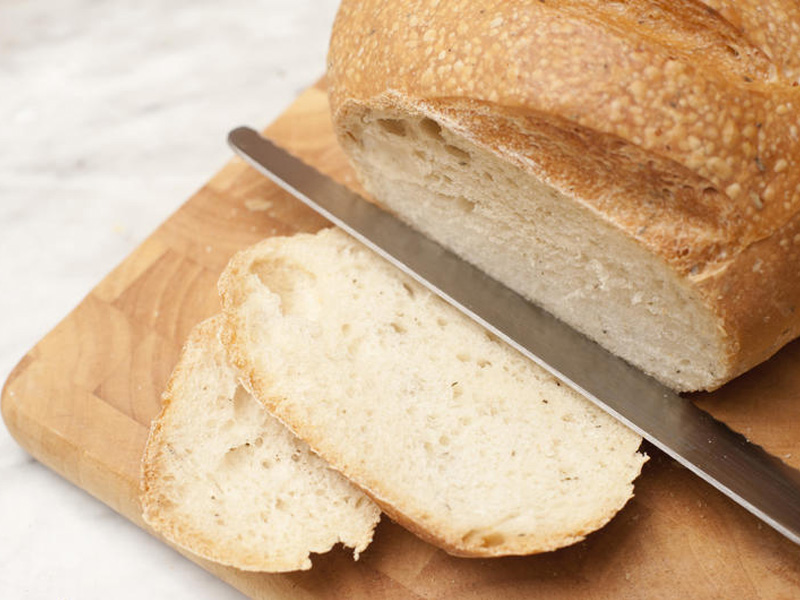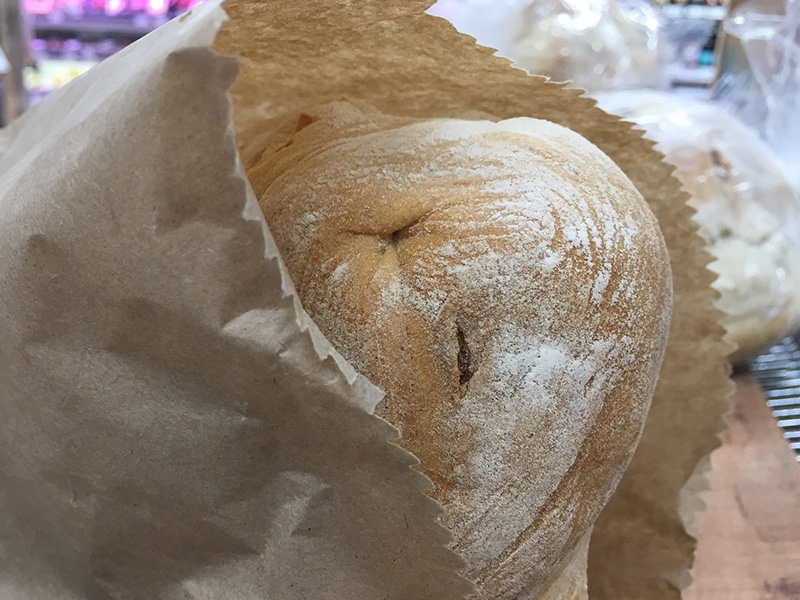Sourdough bread is a delightful treat for the senses: its crusty exterior and soft, tangy crumb can make any meal feel special. But unlike many store-bought breads that are loaded with preservatives to prolong their shelf life, homemade sourdough bread is made with just a few simple ingredients and without any artificial additives. As a result, it can go stale or moldy quite quickly if not stored properly.
But fear not, fellow bread enthusiasts! In this article, we’ll share eight proven methods to help you keep your homemade sourdough bread fresh and delicious for longer, so you can enjoy its amazing flavor and texture for days after baking. Let’s dive in starting with some factors that affect storing your sourdough bread followed by the best ways to store your sourdough bread!
How To Store Sourdough Bread
While there are a lot of ways to store sourdough bread, the main goal is to prevent your fresh bread from going stale or drying out. Here are 5 ways to do that.
- Linen Bread Bag
- Paper Bag
- Reusable Beeswax Wrap
- Breadbox
- Aluminum Foil
Each has its own set of advantages and disadvantages. Read on to learn about which is right for you and why you probably shouldn’t be storing your sourdough in a plastic bag.
Sourdough – Going Stale Vs Drying Out
As any sourdough baker knows, homemade bread can be a true delight, with its crusty exterior and tangy, flavorful crumb. But unfortunately, homemade sourdough bread tends to dry out and go stale much more quickly than store-bought bread, due to the absence of preservatives and other additives.
Understanding the difference between drying out and going stale is important for keeping your bread fresh for as long as possible.
Drying out occurs when the bread loses moisture, resulting in a hard, tough texture. To avoid this, store your bread in a cool, humid place, such as a bread box or a sealed plastic bag.
On the other hand, staling is a natural process that affects all types of bread, including sourdough. When bread is first baked, it is still moist and tender, but over time, its texture and flavor can change. Staling refers to the chemical changes that occur in bread over time, which can cause it to become dry, hard, and less flavorful.
The staling process begins as soon as the bread is removed from the oven, and it happens faster in bread that has a higher proportion of starch to water. This is because starch molecules in the bread gradually lose moisture and reorganize into a more crystalline structure, which makes the bread feel dry and hard. The bread’s flavor can also become less pronounced as it stales, as the aroma compounds that give bread its distinctive flavor are gradually lost.
Sourdough bread, with its lower hydration level, tends to stale more slowly than other types of bread. This is because sourdough bread contains a higher proportion of acid, which can slow down the staling process. The acid in sourdough bread helps to break down the starch molecules in the bread, which can make the bread more tender and moist. Additionally, sourdough bread often contains other flavor compounds that can help to mask any off-flavors that may develop as the bread stales.
Despite its lower hydration level and higher acidity, however, sourdough bread can still go stale over time.
To keep your sourdough bread fresh for longer, it’s important to minimize both drying out and staling.
Let Your Sourdough Bread Breathe: Why You Should Wait to Slice

After you’ve finished baking a delicious loaf of sourdough bread, it’s important to resist the urge to cut into it right away. If you slice the bread too soon after it comes out of the oven, it can become stale or dry out much more quickly. This is because the bread is still undergoing changes even after it has been removed from the oven.
During the cooling process, the bread is still baking internally, which means that it’s still giving off moisture. If you slice into the bread too soon, that moisture will escape, and the bread will become stale or dry out more quickly. Additionally, when you cut into bread that is still warm, it releases steam, which can also contribute to the bread drying out.
To avoid these issues and keep your sourdough bread fresh for longer, it’s best to wait until the bread has cooled completely before slicing into it. This will allow the bread to finish its internal baking process and for the moisture to redistribute evenly throughout the loaf. By doing so, you’ll be able to enjoy your fresh-baked sourdough bread for longer, with all of its delicious flavor and texture intact.
Store Your Sourdough Cut Side Down
When storing your sourdough bread, it’s important to consider the orientation of the loaf. While it may seem like a small detail, storing your bread cut side down can actually help to maintain its freshness for longer.
The reason for this is that the cut side of the bread is more exposed to air, which can cause it to dry out and become stale more quickly. By storing the bread cut side down, you are protecting the exposed area from air exposure and slowing down the staling process.
Keep in mind that storing your bread cut side down may not prevent it from going stale entirely, especially if it has been sliced for several days. However, it can help to extend the life of your bread and maintain its texture and flavor.
Keep Your Sourdough Out Of The Fridge
Many people believe that placing their bread in the refrigerator is the best way to keep it fresh. However, this is actually a common misconception that can lead to stale and dry bread.
The reason for this is that the refrigerator is a very dry environment, which can cause the bread to lose moisture and become stale. In addition, the cold temperature of the refrigerator can actually accelerate the staling process, making the bread go stale more quickly than if it were stored at room temperature.
5 Ways To Store Your Sourdough Bread
Now that we understand some of the factors that affect our sourdough bread when we go to store it, lets explore some of the best ways to store sourdough bread.
Storing Sourdough Bread In A Linen Bag
Storing your sourdough bread in a linen bag is a great way to keep it fresh for longer. Linen bags are breathable, which means that they allow air to circulate around the bread and prevent moisture from building up. This helps to maintain the bread’s texture and flavor while retarding the growth of mold.
To store your sourdough bread in a linen bag, simply place the loaf inside and roll the top of the bag closed. You can then store the bag on the counter or in a breadbox. Linen bags can be washed and reused, making them an eco-friendly option for storing your homemade bread.
Storing Sourdough Bread In A Paper Bag

Storing your sourdough bread in a paper bag is a simple and effective way to keep it fresh. Paper bags are breathable, which allows air to circulate around the bread and prevent moisture from building up. This helps to maintain the bread’s texture and flavor and reduce its chance of molding
To store your sourdough bread in a paper bag, simply place the loaf inside and roll the top of the bag closed. You can then store the bag on the counter or in a breadbox. However, keep in mind that paper bags are not as durable as linen bags or breadboxes, and may tear or rip if handled roughly.
Storing Sourdough Bread In A Reusable Beeswax Wrap
Beeswax wraps or bags are another great way of storing your sourdough bread. The wraps themselves are organic and sustainable, being fully compostable when they need to be discarded.
When it comes to storing bread, beeswax wraps and bags retain more moisture than putting it in a linen bag or wrapping it in a tea towel. This will prevent your bread from drying out too quickly. Additionally, some people claim that the beeswax helps prevent the growth of mold.
Storing Sourdough Bread In A Breadbox
A breadbox is a classic storage solution for keeping bread fresh. These boxes are designed to maintain a consistent temperature and humidity level, which can help to preserve the texture and flavor of your sourdough bread.
To store your sourdough bread in a breadbox, simply place the loaf inside, cut side down, and close the lid. You can then store the box on the counter or in a cool, dry place. One advantage of using a breadbox is that it can help to prevent your bread from becoming dry or stale, while also protecting it from moisture and air.
However, keep in mind that not all breadboxes are created equal. Look for a breadbox that is made of natural materials, such as wood or bamboo, which can help to absorb excess moisture and prevent mold growth. Additionally, make sure to clean your breadbox regularly to prevent the buildup of bacteria or mold.
Overall, storing your sourdough bread in a breadbox can be a great option for maintaining its freshness and flavor.
Storing Sourdough Bread In Aluminum Foil
Aluminum foil is a versatile and affordable option to a bread box for storing your sourdough bread. Wrapping your bread in foil helps to preserve its moisture and prevent it from drying out. This can help to maintain the bread’s texture and flavor for longer.
To store your sourdough bread in aluminum foil, simply wrap the loaf tightly and seal the edges. You can then store the wrapped loaf on the counter or in a breadbox. One advantage of using aluminum foil is that it provides a barrier against air and moisture, which helps to protect your bread from becoming stale or moldy.
However, keep in mind that sourdough bread stored in aluminum foil may not stay fresh for as long as bread stored in a breadbox. This is because the foil can trap excess moisture, which can lead to mold growth if not monitored carefully. If you plan on eating your bread within a few days of baking, storing it in aluminum foil can be a great option. Just make sure to check the bread regularly and discard any slices that have become stale or moldy.
Final Thoughts On Storing Sourdough Bread
Storing sourdough bread can be almost as tricky as baking it in the first place.
If you store your sourdough in too humid of an environment, your bread will mold quickly. If you store it in a low humidity environment, your bread won’t mold, but it will dry out very quickly.
Storing your sourdough bread for long enough to enjoy it means finding a happy balance of being just humid enough to keep your bread moist, without having it immediately start growing mold. The methods of storing your sourdough outlined here give you the best chance of keeping your bread fresh while you get it eaten!








